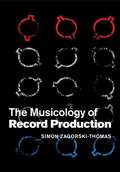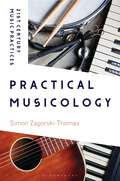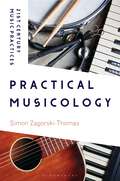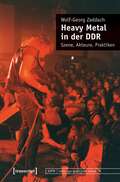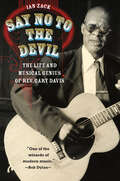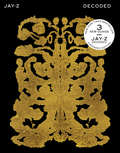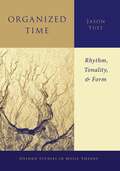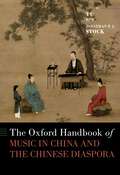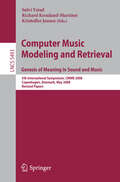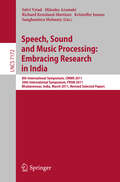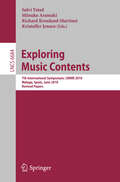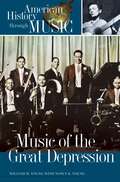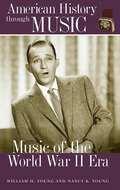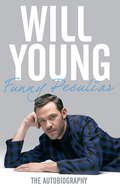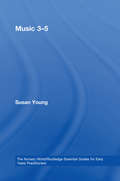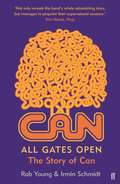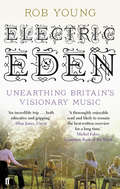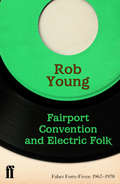- Table View
- List View
The Musicology of Record Production (PDF)
by Simon Zagorski-ThomasRecorded music is as different to live music as film is to theatre. In this book, Simon Zagorski-Thomas employs current theories from psychology and sociology to examine how recorded music is made and how we listen to it. Setting out a framework for the study of recorded music and record production, he explains how recorded music is fundamentally different to live performance, how record production influences our interpretation of musical meaning and how the various participants in the process interact with technology to produce recorded music. He combines ideas from the ecological approach to perception, embodied cognition and the social construction of technological systems to provide a summary of theoretical approaches that are applied to the sound of the music and the creative activity of production. A wide range of examples from Zagorski-Thomas's professional experience reveal these ideas in action.
Practical Musicology (21st Century Music Practices)
by Simon Zagorski-ThomasPractical Musicology outlines a theoretical framework for studying a broad range of current musical practices and aims to provoke discussion about key issues in the rapidly expanding area of practical musicology: the study of how music is made. The book explores various forms of practice ranging from performance and composition to listening and dancing, from historically informed performances of Bach in the USA to Indonesian Dubstep or Australian musical theatre, and from Irish traditional music played by French musicians from Toulouse to Brazilian thrash metal or K-Pop. Drawing on neuroscience, cognitive psychology, ecological approaches in anthropology, and the social construction of technology and creativity, Zagorski-Thomas uses a series of case studies and examples to investigate how practice is already being studied and to suggest a principle for how it might continue to develop, based around the assertion that musicking cannot be treated as a culturally or ideologically neutral phenomenon.
Practical Musicology (21st Century Music Practices)
by Simon Zagorski-ThomasPractical Musicology outlines a theoretical framework for studying a broad range of current musical practices and aims to provoke discussion about key issues in the rapidly expanding area of practical musicology: the study of how music is made. The book explores various forms of practice ranging from performance and composition to listening and dancing, from historically informed performances of Bach in the USA to Indonesian Dubstep or Australian musical theatre, and from Irish traditional music played by French musicians from Toulouse to Brazilian thrash metal or K-Pop. Drawing on neuroscience, cognitive psychology, ecological approaches in anthropology, and the social construction of technology and creativity, Zagorski-Thomas uses a series of case studies and examples to investigate how practice is already being studied and to suggest a principle for how it might continue to develop, based around the assertion that musicking cannot be treated as a culturally or ideologically neutral phenomenon.
Heavy Metal in der DDR: Szene, Akteure, Praktiken (texte zur populären musik #10)
by Wolf-Georg ZaddachDDR und Heavy Metal? Wolf-Georg Zaddach rückt eine in der Forschung lange Zeit vernachlässigte Jugendkultur in den Fokus und erläutert - erstmalig in diesem Umfang - die alltäglichen Praktiken und Entwicklungen der Heavy Metal-Szene im DDR-Sozialismus der 1980er-Jahre. Die empirische Grundlage hierfür bieten bisher unveröffentlichte Quellen wie Songtexte auf Karteikarten, Fan-Briefe und Akten der »Stasi« (Ministerium für Staatssicherheit). Es kommen aber auch zahlreiche Zeitzeugen wie die Macher der Kultradiosendung »Tendenz Hard bis Heavy« sowie diverse Fans und Musiker zu Wort.
Say No to the Devil: The Life and Musical Genius of Rev. Gary Davis
by Ian ZackWho was the greatest of all American guitarists? You probably didn’t name Gary Davis, but many of his musical contemporaries considered him without peer. Bob Dylan called Davis “one of the wizards of modern music.” Bob Weir of the Grateful Dead—who took lessons with Davis—claimed his musical ability “transcended any common notion of a bluesman.” And the folklorist Alan Lomax called him “one of the really great geniuses of American instrumental music.” But you won’t find Davis alongside blues legends Robert Johnson and Muddy Waters in the Rock and Roll Hall of Fame. Despite almost universal renown among his contemporaries, Davis lives today not so much in his own work but through covers of his songs by Dylan, Jackson Browne, and many others, as well as in the untold number of students whose lives he influenced. The first biography of Davis, Say No to the Devil restores “the Rev’s” remarkable story. Drawing on extensive research and interviews with many of Davis’s former students, Ian Zack takes readers through Davis’s difficult beginning as the blind son of sharecroppers in the Jim Crow South to his decision to become an ordained Baptist minister and his move to New York in the early 1940s, where he scraped out a living singing and preaching on street corners and in storefront churches in Harlem. There, he gained entry into a circle of musicians that included, among many others, Lead Belly, Woody Guthrie, and Dave Van Ronk. But in spite of his tremendous musical achievements, Davis never gained broad recognition from an American public that wasn’t sure what to make of his trademark blend of gospel, ragtime, street preaching, and the blues. His personal life was also fraught, troubled by struggles with alcohol, women, and deteriorating health. Zack chronicles this remarkable figure in American music, helping us to understand how he taught and influenced a generation of musicians.
Say No to the Devil: The Life and Musical Genius of Rev. Gary Davis
by Ian ZackWho was the greatest of all American guitarists? You probably didn’t name Gary Davis, but many of his musical contemporaries considered him without peer. Bob Dylan called Davis “one of the wizards of modern music.” Bob Weir of the Grateful Dead—who took lessons with Davis—claimed his musical ability “transcended any common notion of a bluesman.” And the folklorist Alan Lomax called him “one of the really great geniuses of American instrumental music.” But you won’t find Davis alongside blues legends Robert Johnson and Muddy Waters in the Rock and Roll Hall of Fame. Despite almost universal renown among his contemporaries, Davis lives today not so much in his own work but through covers of his songs by Dylan, Jackson Browne, and many others, as well as in the untold number of students whose lives he influenced. The first biography of Davis, Say No to the Devil restores “the Rev’s” remarkable story. Drawing on extensive research and interviews with many of Davis’s former students, Ian Zack takes readers through Davis’s difficult beginning as the blind son of sharecroppers in the Jim Crow South to his decision to become an ordained Baptist minister and his move to New York in the early 1940s, where he scraped out a living singing and preaching on street corners and in storefront churches in Harlem. There, he gained entry into a circle of musicians that included, among many others, Lead Belly, Woody Guthrie, and Dave Van Ronk. But in spite of his tremendous musical achievements, Davis never gained broad recognition from an American public that wasn’t sure what to make of his trademark blend of gospel, ragtime, street preaching, and the blues. His personal life was also fraught, troubled by struggles with alcohol, women, and deteriorating health. Zack chronicles this remarkable figure in American music, helping us to understand how he taught and influenced a generation of musicians.
Say No to the Devil: The Life and Musical Genius of Rev. Gary Davis
by Ian ZackWho was the greatest of all American guitarists? You probably didn’t name Gary Davis, but many of his musical contemporaries considered him without peer. Bob Dylan called Davis “one of the wizards of modern music.” Bob Weir of the Grateful Dead—who took lessons with Davis—claimed his musical ability “transcended any common notion of a bluesman.” And the folklorist Alan Lomax called him “one of the really great geniuses of American instrumental music.” But you won’t find Davis alongside blues legends Robert Johnson and Muddy Waters in the Rock and Roll Hall of Fame. Despite almost universal renown among his contemporaries, Davis lives today not so much in his own work but through covers of his songs by Dylan, Jackson Browne, and many others, as well as in the untold number of students whose lives he influenced. The first biography of Davis, Say No to the Devil restores “the Rev’s” remarkable story. Drawing on extensive research and interviews with many of Davis’s former students, Ian Zack takes readers through Davis’s difficult beginning as the blind son of sharecroppers in the Jim Crow South to his decision to become an ordained Baptist minister and his move to New York in the early 1940s, where he scraped out a living singing and preaching on street corners and in storefront churches in Harlem. There, he gained entry into a circle of musicians that included, among many others, Lead Belly, Woody Guthrie, and Dave Van Ronk. But in spite of his tremendous musical achievements, Davis never gained broad recognition from an American public that wasn’t sure what to make of his trademark blend of gospel, ragtime, street preaching, and the blues. His personal life was also fraught, troubled by struggles with alcohol, women, and deteriorating health. Zack chronicles this remarkable figure in American music, helping us to understand how he taught and influenced a generation of musicians.
Say No to the Devil: The Life and Musical Genius of Rev. Gary Davis
by Ian ZackWho was the greatest of all American guitarists? You probably didn’t name Gary Davis, but many of his musical contemporaries considered him without peer. Bob Dylan called Davis “one of the wizards of modern music.” Bob Weir of the Grateful Dead—who took lessons with Davis—claimed his musical ability “transcended any common notion of a bluesman.” And the folklorist Alan Lomax called him “one of the really great geniuses of American instrumental music.” But you won’t find Davis alongside blues legends Robert Johnson and Muddy Waters in the Rock and Roll Hall of Fame. Despite almost universal renown among his contemporaries, Davis lives today not so much in his own work but through covers of his songs by Dylan, Jackson Browne, and many others, as well as in the untold number of students whose lives he influenced. The first biography of Davis, Say No to the Devil restores “the Rev’s” remarkable story. Drawing on extensive research and interviews with many of Davis’s former students, Ian Zack takes readers through Davis’s difficult beginning as the blind son of sharecroppers in the Jim Crow South to his decision to become an ordained Baptist minister and his move to New York in the early 1940s, where he scraped out a living singing and preaching on street corners and in storefront churches in Harlem. There, he gained entry into a circle of musicians that included, among many others, Lead Belly, Woody Guthrie, and Dave Van Ronk. But in spite of his tremendous musical achievements, Davis never gained broad recognition from an American public that wasn’t sure what to make of his trademark blend of gospel, ragtime, street preaching, and the blues. His personal life was also fraught, troubled by struggles with alcohol, women, and deteriorating health. Zack chronicles this remarkable figure in American music, helping us to understand how he taught and influenced a generation of musicians.
Say No to the Devil: The Life and Musical Genius of Rev. Gary Davis
by Ian ZackWho was the greatest of all American guitarists? You probably didn’t name Gary Davis, but many of his musical contemporaries considered him without peer. Bob Dylan called Davis “one of the wizards of modern music.” Bob Weir of the Grateful Dead—who took lessons with Davis—claimed his musical ability “transcended any common notion of a bluesman.” And the folklorist Alan Lomax called him “one of the really great geniuses of American instrumental music.” But you won’t find Davis alongside blues legends Robert Johnson and Muddy Waters in the Rock and Roll Hall of Fame. Despite almost universal renown among his contemporaries, Davis lives today not so much in his own work but through covers of his songs by Dylan, Jackson Browne, and many others, as well as in the untold number of students whose lives he influenced. The first biography of Davis, Say No to the Devil restores “the Rev’s” remarkable story. Drawing on extensive research and interviews with many of Davis’s former students, Ian Zack takes readers through Davis’s difficult beginning as the blind son of sharecroppers in the Jim Crow South to his decision to become an ordained Baptist minister and his move to New York in the early 1940s, where he scraped out a living singing and preaching on street corners and in storefront churches in Harlem. There, he gained entry into a circle of musicians that included, among many others, Lead Belly, Woody Guthrie, and Dave Van Ronk. But in spite of his tremendous musical achievements, Davis never gained broad recognition from an American public that wasn’t sure what to make of his trademark blend of gospel, ragtime, street preaching, and the blues. His personal life was also fraught, troubled by struggles with alcohol, women, and deteriorating health. Zack chronicles this remarkable figure in American music, helping us to understand how he taught and influenced a generation of musicians.
Say No to the Devil: The Life and Musical Genius of Rev. Gary Davis
by Ian ZackWho was the greatest of all American guitarists? You probably didn’t name Gary Davis, but many of his musical contemporaries considered him without peer. Bob Dylan called Davis “one of the wizards of modern music.” Bob Weir of the Grateful Dead—who took lessons with Davis—claimed his musical ability “transcended any common notion of a bluesman.” And the folklorist Alan Lomax called him “one of the really great geniuses of American instrumental music.” But you won’t find Davis alongside blues legends Robert Johnson and Muddy Waters in the Rock and Roll Hall of Fame. Despite almost universal renown among his contemporaries, Davis lives today not so much in his own work but through covers of his songs by Dylan, Jackson Browne, and many others, as well as in the untold number of students whose lives he influenced. The first biography of Davis, Say No to the Devil restores “the Rev’s” remarkable story. Drawing on extensive research and interviews with many of Davis’s former students, Ian Zack takes readers through Davis’s difficult beginning as the blind son of sharecroppers in the Jim Crow South to his decision to become an ordained Baptist minister and his move to New York in the early 1940s, where he scraped out a living singing and preaching on street corners and in storefront churches in Harlem. There, he gained entry into a circle of musicians that included, among many others, Lead Belly, Woody Guthrie, and Dave Van Ronk. But in spite of his tremendous musical achievements, Davis never gained broad recognition from an American public that wasn’t sure what to make of his trademark blend of gospel, ragtime, street preaching, and the blues. His personal life was also fraught, troubled by struggles with alcohol, women, and deteriorating health. Zack chronicles this remarkable figure in American music, helping us to understand how he taught and influenced a generation of musicians.
Decoded
by Jay ZUpdated with 3 new songs, this is the intimate, first-person chronicle of the life and work of Jay-Z, born Shawn Carter in Brooklyn's notorious Marcy Projects, now known to many as the greatest rapper alive. Told through lyrics, images and personal narrative, Decoded shares the story of Jay-Z's life through the 10 codes that define him, giving an unparalleled insight into his background, influences and the artistic process that shapes his work. Each chapter features a highly personal narrative section followed by a visually captivating selection of his most famous and provocative lyrics underlining the chapter's themes, along with Jay-Z's own 'decoding' of each lyric, uncovering the wordplay and stories behind the song.This is a brilliant insight into the art and poetry of hip-hop, as well as the life of one of the genre's greatest artists.
Organized Time: Rhythm, Tonality, and Form (Oxford Studies in Music Theory)
by Jason YustOrganized Time is the first attempt to unite theories of harmony, rhythm and meter, and form under a common idea of structured time. Building off of recent advances in music theory in essential subfields-rhythmic theory, tonal structure, and the theory of musical form--author Jason Yust demonstrates that tonal music exhibits similar hierarchical organization in each of these dimensions. Yust develops a network model for temporal structure with an application of mathematical graph theory, which leads ultimately to musical applications of a multi-dimensional polytope called the associahedron. A wealth of analytical examples includes not only the familiar tonal canon-J.S. Bach, Mozart, Schumann--but also lesser known masters of the musical Enlightenment such as C.P.E. and J.C. Bach, Boccherini, and Johann Gottlieb Graun. Yust's approach has wide-ranging ramifications across music theory, enabling new approaches to musical closure, hypermeter, formal function, syncopation, and rhythmic dissonance, as well as historical observations about the development of sonata form and the innovations of Haydn and Beethoven. Making a forceful argument for the independence of musical modalities and for a multivalent approach to music analysis, Organized Time establishes the aesthetic importance of structural disjunction, the conflict of structure in different modalities, in numerous analytical contexts.
Organized Time: Rhythm, Tonality, and Form (Oxford Studies in Music Theory)
by Jason YustOrganized Time is the first attempt to unite theories of harmony, rhythm and meter, and form under a common idea of structured time. Building off of recent advances in music theory in essential subfields-rhythmic theory, tonal structure, and the theory of musical form--author Jason Yust demonstrates that tonal music exhibits similar hierarchical organization in each of these dimensions. Yust develops a network model for temporal structure with an application of mathematical graph theory, which leads ultimately to musical applications of a multi-dimensional polytope called the associahedron. A wealth of analytical examples includes not only the familiar tonal canon-J.S. Bach, Mozart, Schumann--but also lesser known masters of the musical Enlightenment such as C.P.E. and J.C. Bach, Boccherini, and Johann Gottlieb Graun. Yust's approach has wide-ranging ramifications across music theory, enabling new approaches to musical closure, hypermeter, formal function, syncopation, and rhythmic dissonance, as well as historical observations about the development of sonata form and the innovations of Haydn and Beethoven. Making a forceful argument for the independence of musical modalities and for a multivalent approach to music analysis, Organized Time establishes the aesthetic importance of structural disjunction, the conflict of structure in different modalities, in numerous analytical contexts.
The Oxford Handbook of Music in China and the Chinese Diaspora (OXFORD HANDBOOKS SERIES)
by Yu Hui and Jonathan P. J. StockIn The Oxford Handbook of Music in China and the Chinese Diaspora, twenty-three scholars advance knowledge and understandings of Chinese music studies. Each contribution develops a theoretical model to illuminate new insights into a key musical genre or context. This handbook is categorized into three parts. In Part One, authors explore the extensive, remarkable, and polyvocal historical legacies of Chinese music. Ranging from archaeological findings to the creation of music history, chapters address enduring historical practices and emerging cultural expressions. Part Two focuses on evolving practice across a spectrum of key instrumental and vocal genres. Each chapter provides a portrait of musical change, tying musical transformations to the social dimensions underpinning that change. Part Three responds to the role that prominent issues, including sexuality, humanism, the amateur, and ethnicity, play in the broad field of Chinese music studies. Scholars present systematic orientations for researchers in the third decade of the twenty-first century. This volume incorporates extensive input from researchers based in China, Taiwan, and among Chinese communities across the world. Using a model of collaborative inquiry, The Oxford Handbook of Music in China and the Chinese Diaspora features diverse insider voices alongside authors positioned across the anglophone world.
Computer Music Modeling and Retrieval. Genesis of Meaning in Sound and Music: 5th International Symposium, CMMR 2008 Copenhagen, Denmark, May 19-23, 2008 Revised Papers (Lecture Notes in Computer Science #5493)
by Sølvi Ystad Richard Kronland-Martinet Kristoffer JensenSpeech, Sound and Music Processing: 8th International Symposium, CMMR 2011 and 20th International Symposium, FRSM 2011, Bhubaneswar, India, March 9-12, 2011, Revised Selected Papers (Lecture Notes in Computer Science #7172)
by Sølvi Ystad Mitsuko Aramaki Richard Kronland-Martinet Kristoffer Jensen Sanghamitra MohantyThis book constitutes the thoroughly refereed post-proceedings of the 8th International Symposium on Computer Music Modeling and Retrieval, CMMR 2011 and the 20th International Symposium on Frontiers of Research in Speech and Music, FRSM 2011. This year the 2 conferences merged for the first time and were held in Bhubanes, India, in March 2011. The 17 revised full papers presented were specially reviewed and revised for inclusion in this proceedings volume. The book is divided in four main chapters which reflect the high quality of the sessions of CMMR 2011, the collaboration with FRSM 2011 and the Indian influence, in the topics of Indian Music, Music Information Retrieval, Sound analysis synthesis and perception and Speech processing of Indian languages.
Exploring Music Contents: 7th International Symposium, CMMR 2010, Málaga, Spain, June 21-24, 2010. Revised Papers (Lecture Notes in Computer Science #6684)
by Solvi Ystad Mitsuko Aramaki Richard Kronland-Martinet Kristoffer JensenThis book constitutes the thoroughly refereed post-proceedings of the 7th International Symposium on Computer Music Modeling and Retrieval, CMMR 2010, held in Málaga, Spain, in June 2010. The 22 revised full papers presented were specially reviewed and revised for inclusion in this proceedings volume. The book is divided in five main chapters which reflect the present challenges within the field of computer music modeling and retrieval. The chapters range from music interaction, composition tools and sound source separation to data mining and music libraries. One chapter is also dedicated to perceptual and cognitive aspects that are currently subject to increased interest in the MIR community.
Music of the Great Depression (American History through Music)
by William H. Young Nancy K. YoungPrior to the stock market crash of 1929 American music still possessed a distinct tendency towards elitism, as songwriters and composers sought to avoid the mass appeal that critics scorned. During the Depression, however, radio came to dominate the other musical media of the time, and a new era of truly popular music was born. Under the guidance of the great Duke Ellington and a number of other talented and charismatic performers, swing music unified the public consciousness like no other musical form before or since. At the same time the enduring legacies of Woody Guthrie in folk, Aaron Copeland in classical, and George and Ira Gershwin on Broadway stand as a testament to the great diversity of tastes and interests that subsisted throughout the Great Depression, and play a part still in our lives today. The lives of these and many other great musicians come alive in this insightful study of the works, artists, and circumstances that contributed to making and performing the music that helped America through one of its most difficult times.The American History through Music series examines the many different styles of music that have played a significant part in our nation's history. While volumes in this series show the multifaceted roles of music in our culture, they also use music as a lens through which readers may study American social history. The authors present in-depth analysis of American musical genres, significant musicians, technological innovations, and the many connections between music and the realms of art, politics, and daily life.
Music of the World War II Era (American History through Music)
by William H. Young Nancy K. YoungIn the World War II era, big bands and swing music reached the heights of popularity with soldiers as well as friends and loved ones back home. Many entertainers such as Glenn Miller also served in the military, or supported the war effort with bond drives and entertaining the troops at home and abroad. In addition to big band and swing music, musicals, jazz, blues, gospel and country music were also popular. Chapters on each, along with an analysis of the evolution of record companies, records, radios, and television are included here, for students, historians, and fans of the era.Includes a timeline of the music of the era, an appendix of the Broadway and Hollywood Musicals, 1939-1945, and an appendix of Songs, Composers, and lyricists, 1939-1945. An extensive discography and bibliography, along with approximately 35 black and white photos, complete the volume.
Funny Peculiar: The Autobiography
by Will YoungWith free audio samplerIn 2001 Will Young shot to fame as the first winner of Pop Idol. It was clear from the start that he would never be a typical pop star - and more than ten years later he has become one of our best-loved and most intriguing artists.From his dramatic experiences on Pop Idol; to coming out in the glare of the media spotlight; to his valiant struggles against depression; to the crazy reality of being famous, Will is open about both the highs and lows of his life. He also provides sound and practical advice on dealing with the DVLA helpline - something that has been woefully neglected by all other celebrity memoirs.If you have ever wondered what it's like to attend a fashion show (and find yourself accidentally waving at Anna Wintour); how it feels to sing in front of thousands while fighting a catastrophic bout of low self-esteem; or be subjected to the terror that is a This Morning 'makeover', then Funny Peculiar reveals all. It also reveals what not to say if you ever meet David Beckham.Moving, witty and scrupulously honest, Funny Peculiar is a refreshingly different and fascinating autobiography by a true original.
Music 3-5
by Susan YoungThis book gives information, ideas and principles for music with three to five year olds that are both down-to-earth and up-to-date. Written in a style which is engaging and readable, it integrates recent theory and practice illustrating the discussion with examples and ideas taken from real life. Chapters in this inspiring and engaging book show practitioners how to: connect with the educational concepts and principles of using music in early years settings recognise and understand children's musical starting points foster creativity through music support listening and communication through music learn the key areas of listening, singing, using instruments and dancing develop children's musical understanding widen opportunities for music through resources, new technologies and visiting artist projects. Early years practitioners and students will find this a valuable introduction to music with young children. More experienced practitioners will find the contemporary ideas a source of inspiration. Books in this series address key issues for early years practitioners working in today's Foundation Stage environments. Each title is packed full of practical activities, support, advice and guidance, all of which is in line with current government early years policy. The authors use their experience and expertise to write accessibly and informatively, emphasising through the use of case studies the practical aspects of the subject, whilst retaining strong theoretical underpinnings throughout.
Music 3-5 (PDF)
by Susan YoungThis book gives information, ideas and principles for music with three to five year olds that are both down-to-earth and up-to-date. Written in a style which is engaging and readable, it integrates recent theory and practice illustrating the discussion with examples and ideas taken from real life. Chapters in this inspiring and engaging book show practitioners how to: connect with the educational concepts and principles of using music in early years settings recognise and understand children's musical starting points foster creativity through music support listening and communication through music learn the key areas of listening, singing, using instruments and dancing develop children's musical understanding widen opportunities for music through resources, new technologies and visiting artist projects. Early years practitioners and students will find this a valuable introduction to music with young children. More experienced practitioners will find the contemporary ideas a source of inspiration. Books in this series address key issues for early years practitioners working in today's Foundation Stage environments. Each title is packed full of practical activities, support, advice and guidance, all of which is in line with current government early years policy. The authors use their experience and expertise to write accessibly and informatively, emphasising through the use of case studies the practical aspects of the subject, whilst retaining strong theoretical underpinnings throughout.
All Gates Open: The Story of Can
by Rob Young Irmin SchmidtAll Gates Open presents the definitive story of arguably the most influential and revered avant-garde band of the late twentieth century: CAN. It consists of two books. In Book One, Rob Young gives us the full biography of a band that emerged at the vanguard of what would come to be called the Krautrock scene in late sixties Cologne. With Irmin Schmidt and Holger Czukay - two classically trained students of Stockhausen - at the heart of the band, CAN's studio and live performances burned an incendiary trail through the decade that followed: and left a legacy that is still reverberating today in hip hop, post rock, ambient, and countless other genres. Rob Young's account draws on unique interviews with all founding members of CAN, as well as their vocalists, friends and music industry associates. And he revisits the music, which is still deliriously innovative and unclassifiable more than four decades on. All Gates Open is a portrait of a group who worked with visionary intensity and belief, outside the system and inside their own inner space. Book Two, Can Kiosk, has been assembled by Irmin Schmidt, founding member and guiding spirit of the band, as a 'collage - a technique long associated with CAN's approach to recording. There is an oral history of the band drawing on interviews that Irmin made with musicians who see CAN as an influence - such as Bobby Gillespie, Geoff Barrow, Daniel Miller, and many others. There are also interviews with artists and filmmakers like Wim Wenders and John Malkovitch, where Schmidt reflects on more personal matters and his work with film. Extracts of Schmidt's notebook and diaries from 2013-14 are also reproduced as a reflection on the creative process, and the memories, dreams, and epiphanies it entails. Can Kiosk offers further perspectives on a band that have inspired several generations of musicians and filmmakers in the voices of the artists themselves. CAN were unique, and their legacy is articulated in two books in this volume with the depth, rigour, originality, and intensity associated with the band itself. It is illustrated throughout with previously unseen art, photographs, and ephemera from the band's archive.
Electric Eden: Unearthing Britain's Visionary Music
by Rob YoungElectric Eden documents one of the great untold stories of British music over the past century. While ostensibly purporting to be a history of that much derided (though currently fashionable) four-letter word, 'folk', Electric Eden will be a magnificent survey of the visionary, topographic and esoteric impulses that have driven the margins of British visionary folk music from Vaughan Williams and Holst to The Incredible String Band, Nick Drake, John Martyn and Aphex Twin. For the first time the full story of the extraordinary period of folk rock from the mid 1960s to the mid 1970s will be told in a book with the breadth of a social history touching on sonic worship, pagan architecture, land art, ley lines and ther outer fringes of the avant garde. Electric Eden identifies a particularly English wellspring of imagery and imagination, an undercurrent that has fed into the creative and organic strand of Britain's music over the past century. From Edwardian composers assimilations of folk song and visionary poetry, via folk rock of the 60s and 70s, the story is brought up to date by placing these earlier movements in a continuum that links through significant figures in 21st century pastoral electronica.
Fairport Convention and Electric Folk: Faber Forty-Fives: 1967–1970 (Faber Forty-Fives #2)
by Rob YoungFairport Convention and Electric Folk tells of the blossoming of British folk music in the late sixties, as rediscovered pastoral sensibilities aligned themselves with electric instrumentation. The album that spearheaded this gentle revival was Fairport Convention's Liege and Lief - a bewitching mix of time-honoured standards and band originals, wove through with Sandy Denny's haunting voice and Richard Thompson's remarkable guitar playing. The scene that developed found its ideals in the bucolic and the communal, in Albion and its traditions, and included such influential bands and artists as Steeleye Span, John and Beverley Martyn, and Nick Drake.
